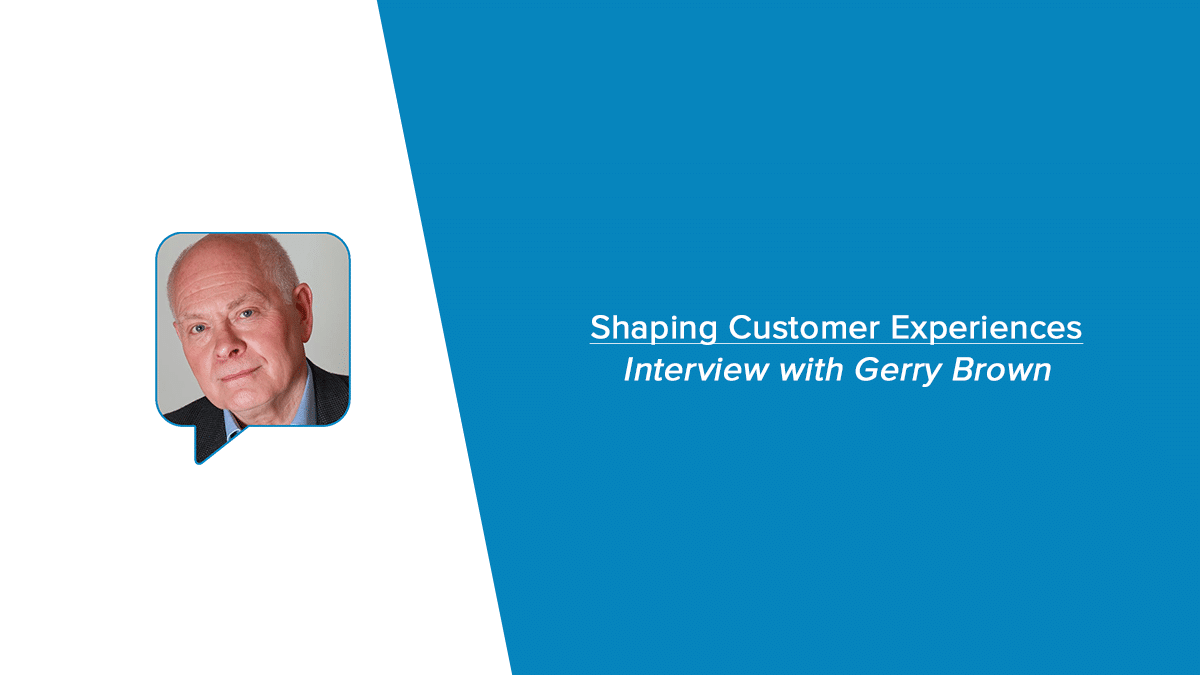
Gerry Brown has had an expansive and lengthy career in customer experience, working with companies throughout the UK, Canada, and EMEA. Known as The Customer Lifeguard, Gerry has been busy saving enterprises from drowning in an ocean of indifference with tips to increase their customer engagement, align their strategies across the organization, and identifying areas to improve the experience for their customers.
He is a CCXP (Certified Customer Experience Professional), a member of the Professional Speaking Association (PSA) and the Global Speakers Federation (GSF).
A published author, speaker, and consultant. Gerry covers a range of issues in this interview including how enabling technology and processes can bring customers’ experiences to life, address the challenges facing companies, and create differentiation.
Can you introduce yourself and tell us about your background?
I have been involved in helping companies enhance their customer engagement operations for over 40 years – and certainly before customer experience became an industry unto itself.
I worked with Bell Canada to assist businesses to develop closer, deeper, more valuable relationships with their customers and increase sales through more frequent and effective use of the phone. And while telemarketing now has a less than auspicious reputation, it gave me an early insight into the endearing value of being yourself, recognizing and responding to customer emotions and the power of respectful, thoughtful and courteous conversation – Which plays a major role in the work I do with customers to this day.
After various roles with leading technology vendors, I started my own business in 2004 and which now focuses on helping customers align customer experience ambition with operational reality, linking their strategy with enabling technology, engaged employees, and sensible, customer-friendly processes to bring customer experience to life.
What are the biggest challenges facing organizations today to deliver a consistent and memorable Customer Experience?
On the strategy side, companies fail to really empower employees, even if they say they do and leave them floundering in a sea of uncertainty and lacking direction in a difficult customer situation. Many businesses lack a truly cross-functional team to design the customer experience and create a CX blueprint that ensures that everyone understands what good looks and feels like. Consequently, they often struggle to identify their real purpose and to get everyone in the company rowing in the same direction and often even in the same boat. It’s called silos.
Operationally, they don’t eliminate dumb policies and procedures, which create unnecessary friction and frustration for customers and the colleagues that must try to explain them. Their technology is often aging, creaking and disconnected, which means they can’t deliver the seamless service that they promise, which leads to longer, costlier interactions and more excuses from colleagues.
Can you tell us about the best Customer Experience you’ve ever had? And the worst one?
There’s no shortage of either type, but recently an interaction with Autoglass left me with a smile on my face. I had a minor issue with an online appointment and the associated call and decided to email the UK MD as I knew this was out of character with their high customer service standards. I had a response from one of his team within 30 minutes that came with a courteous and heartfelt apology and a commitment that they would take full responsibility to resolve the issue, which they did by picking up my car, taking it to their repair depot, fixing the glass and returning the car in less than three hours. By recognizing and acknowledging the issue, and having one person take full accountability for resolution, fulfillment, and follow-up, they created a customer for life.
It’s hard to figure out the worst of the worst, but it’s bound to be telephone related. Following a move a few years ago I arranged for my business broadband to be installed & confirmed the date and time slot, which was an afternoon appointment. The installer arrived in the morning, called me, as I wasn’t at the premise, claimed that he had the right time, despite me having confirming emails and texts for a time slot and then just left, telling me to make another appointment. Fortunately, a call to the company confirmed that I was correct, and they sent the installer back, but I guess in a fit of pique he decided to make me pay and the installation failed a few hours later. Several days later it was put right by a more polite and knowledgeable installer, but the bad taste remained. The moral of the story: the customer may not always be right, but they will always be the customer.

What are the challenges that companies face with legacy technology?
Slow, cumbersome legacy systems generate pain, stress, and inefficiencies, and lack the agility that organizations need when all that customers want is effortless, fast and effective service. Companies often have 10 or more legacy systems that don’t talk to each other and consequently the myth of seamless experience is once again cruelly exposed. The costs to upgrade and maintain them are also generally high and the time to complete these changes can be extensive as well as potentially causing major outages and customer inconvenience as was demonstrated by the TSB Bank upgrade in 2018. Agents are equally challenged and find themselves cutting, pasting, toggling, swearing and leaving, usually in that order.
How can they meet these challenges without a complete technology replacement program?
Companies believe that it’s too expensive and time consuming to fix it, which of course it is, if you think there needs to be a complete rip and replace program. This won’t be news, but the answer is in the clouds and that is Cloud computing which offers lower start-up costs, shorter implementation times, and less dependence on IT.
Many cloud solutions offer low cost, or no cost, trial periods which allow organizations to test the applications in a real-world or test environment, before deciding to proceed. As a subscription model, companies can also manage their investment carefully, and users can be brought on as required with flexibility in both data and capability, and with a minimum of IT involvement.
The challenge that most businesses face is that information and customer data all reside in different places and in different forms, and often in legacy systems, as noted earlier. The Cloud provides a perfect way to synchronize or normalize all this so-called “Big Data” across these different locations and systems, to move closer to the single view of the customer without significantly adding to your existing IT infrastructure.
These applications usually feature more open “Application Programming Interfaces” (APIs) that can make system integration easier, quicker and much less expensive. Companies will find that, even with older legacy systems, they can still use the cloud to push and pull data to and from the right places, thereby increasing their ability to provide a total view of the customer and deliver a great customer experience.
What significant impact has digital transformation had on Customer Experience?
With an increasing number of transactions taking place on mobile devices and many new financial service applications being digital-only, this has forced all companies to recognize the importance of delivering services based on the customer’s choice of contact channel. However, it’s important to keep in mind that organizations must adopt a digital experience framework and integration mindset and capability closely aligned to the CX strategy and that starts with the customers’ needs and expectations clearly in mind.
To validate this a key question to ask is, does the digital program increase differentiation, create new routes to market and/or develop business models?
Simply having an app that your competitors don’t have is unlikely to be a significant differentiator for very long as they will probably catch up quite soon. So once again your team needs to be clear on the business benefits of the differentiation, its lifecycle, financial value, and customer satisfaction benefits. Monitor changes that are happening in your market segment and territories. Are customer and colleague expectations changing and what are your competitors doing to adapt?
A good way to look at this is to say, “Would we do it anyway?”, even if it wasn’t based on a digital element. Clearly looking at new markets that can benefit from “always-on” and/or 24/7 capabilities that digital can bring is one way to evaluate the power of that reach. This should allow for a clear financial analysis based on the size and potential of the market. Also, by identifying customer activity in terms of type, location and outcome will help you focus on where legacy systems and business processes are damaging the customer experience and present opportunities for improvement.

As part of the Customer Experience, how important is it for businesses to be Omni-Digital?
(Note: Omni-Digital is a similar strategy as Omni-Channel to provide a consistent experience across all digital channels)
As I noted in my legacy comments, data resides in many different places both internally and externally, and it’s vital that it can be brought together in a timely and relevant fashion irrespective of channel. This doesn’t mean that every channel provides exactly the same experience, but it must provide a consistent experience, and this is where digital plays a key role in being able to quickly locate, present and action the data irrespective of location
For many businesses digital capabilities seem to be developed in isolation, in a dark room and without input from customers or front-line colleagues. Consequently, having a truly collaborative environment will help to develop the guiding principles and uncover a clear connection between the digital framework and the broader customer engagement and CX imperatives that drive them. It will also provide the organization with a road map that has been plotted on strong multi-departmental and customer experience principles to deliver the robust and flexible integration they need that can connect content, data, and systems to unify marketing, commerce, and service processes over multiple touchpoints.
What’s the most common phrase heard from Customer Service advisers and why?
“My system’s slow today”, which is code for, “I have to toggle between so many different systems that I’ve lost the will to live.” This is due to the challenges that they face with legacy systems that I noted earlier. You may also hear “Please bear with me” or “Can I put you on hold”, which are born in the same place and reflective of advisers trying desperately to find the customer information in a sea of disparate and glacially slow systems.
Is there anything else you would like to talk about?
There was much written recently about whether or not customer experience has hit the buffers or indeed, according to one pundit, it may be dying! But perhaps like Monty Python’s parrot, it is just resting. Paraphrasing the impassioned plea from the 1976 film Network, I believe that many people are “mad as hell and not going to take it anymore”, that changes are afoot and that the political populist movement that is now part of our lives will have an equal impact on business.
Businesses, as well as people, will recognize that while change isn’t mandatory, neither is survival. This will not only depend on just keeping up but being one of the leaders. Translating 2019 populism into positive and measurable business action requires a more collaborative, engaging and caring environment. While that may be a pipe dream in many nationalistic and existential struggles, it’s not beyond the realms of possibility in a corporate world. All of us, as customers, continue to have multiple daily interactions that shape our view of what a great customer experience should be. And this is slowly yet surely having a positive impact on businesses where we work. It is creating a culture of increased responsibility, enhanced engagement and new levels of employee empowerment that is clearly more than the sum of its influences.
The new consumers are increasingly more discerning, vocal and active and forward-thinking businesses and their leaders, with strong support from their customer teams, are starting to realize that when customers win, their hearts and minds will surely follow!
To find out more about Gerry and his work helping companies steer clear of bad customer service stories, you can follow him on Twitter and LinkedIn.
His new book “When a Customer Wins, Nobody Loses”, full of common-sense ideas, simply stated, easily started, quickly adopted and financially sensible is available now.
Originally published Aug 29, 2019, updated Dec 30, 2022




